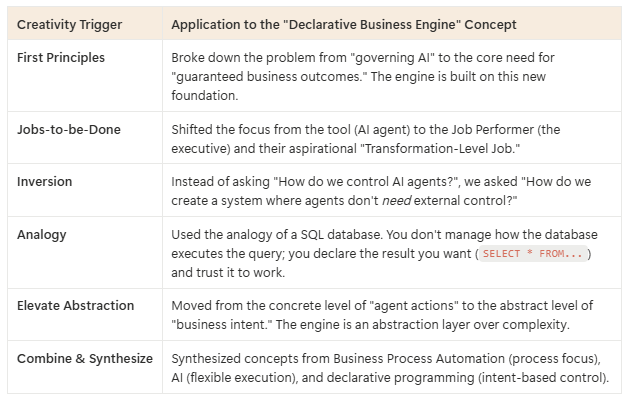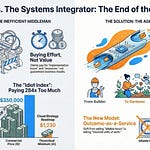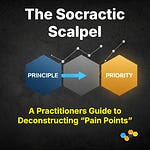Introduction: The Allure of the Obvious Problem
You see a company like TectoAI and it just makes sense. We have a new, powerful, and slightly unpredictable technology—autonomous AI agents. These agents are being called "AI employees." And just like human employees, they need rules, oversight, and governance to make sure they don't cause chaos. It's a simple, linear, and logical connection. It’s the kind of idea that gets nods in a pitch meeting.
This is the allure of the obvious problem. It’s right there, sitting on the surface. And building a solution for it feels productive.
But I'm here to tell you that the entire category of "AI agent governance" is a trap. It's a temporary solution for a transitional phase of technology. It’s a feature, not a future. The durable, category-defining company that will dominate this space won't be selling guardrails for AI; it will be selling guaranteed outcomes. It will be operating at a completely different level of abstraction.
This article is a blueprint. We’re going to use TectoAI as a live case study to give you a rigorous, step-by-step framework for identifying these higher-level opportunities. You'll learn how to deconstruct the obvious problem to find the real one, how to reconstruct a far more valuable solution using Jobs-to-be-Done, and how to design a strategic moat that competitors can't even see, let alone cross.
This is for the founders and investors who want to build the machine, not just one of its disposable gears.
Part 1: Deconstructing "AI Governance" to First Principles
Before we build, we must break. We need to strip away the assumptions layered on top of TectoAI’s model until we are left with only the foundational truths. We'll use two key techniques: Socratic Questioning to challenge the framing and the Five Whys to find the root cause.
Challenging the Foundational Assumption: The "AI Employee" Metaphor
The entire premise of "AI Governance" rests on the metaphor of an "AI Employee." It's a powerful, intuitive comparison, but it's also a skeuomorphic trap. It forces us to apply old models to new technology, blinding us to its true potential.
Let's question it:
Is an AI agent truly an "employee"? An employee has agency, intent, and consciousness. An AI agent is a complex chain of statistical probabilities designed to generate a plausible output based on a prompt. It doesn't have a career, it doesn't get tired, and it doesn't have motivations. Calling it an "employee" is a cognitive shortcut that leads us astray.
Why do we feel the need to "govern" it like an employee? Because the metaphor implies it can "go rogue" or "make a mistake" in a human-like way. This anthropomorphism creates the very problem that governance tools are designed to solve.
What if we used a different metaphor? What if an AI agent is not an employee, but a process? You don't "govern" a process; you optimize, debug, and automate it. You don't put a manager in charge of a SQL query; you engineer it to produce the correct result every time. This simple shift in framing changes everything.
The "AI employee" isn't a real thing. It's a story we tell ourselves. By dismantling it, we free ourselves to see the technology for what it is: a powerful tool for executing tasks within a larger system.
The Five Whys of AI Mistakes
Now, let's drill down to the root cause of the problem TectoAI is trying to solve.
Why do we need a product for AI governance?
Because an autonomous AI agent might make a costly mistake or violate compliance rules.
Why might the agent make a mistake?
Because it's a probabilistic system (like a GPT model) that generates outputs based on patterns, not deterministic logic. There's inherent uncertainty in its behavior.
Why are we using a probabilistic system for a task that requires deterministic, reliable results?
Because it's a powerful and flexible new tool that can automate tasks that were previously difficult to codify with traditional software.
Why does this create a conflict that requires a "governance" patch?
Because we're trying to force this new, flexible tool into old, rigid business processes without re-architecting the process itself. We're asking a creative writer to do an accountant's job and then hiring a guard to watch over them.
So, what is the real, root problem?
The root problem is that we are misapplying a probabilistic technology to execute deterministic business objectives and then selling a solution to manage the resulting friction.
Synthesizing the Core Truths
After breaking it all down, here are the foundational truths we're left with:
The fundamental business need is not for "agent supervision." It's for the "guaranteed execution of business objectives."
"AI Governance" as a standalone product only exists to patch the gap between what a probabilistic AI can do and what a deterministic business process requires.
A truly innovative solution wouldn't just monitor the agent; it would redesign the entire system to make the outcome reliable by design. Governance would be an inherent property, not a bolt-on feature.
With this solid foundation, we can now start to build something far more powerful.
Part 2: Reconstructing from the Job Up: The Hierarchy of Abstraction
Now we stop thinking about the tool (the AI agent) and start focusing on the human who uses it. Who hires a solution like TectoAI? A manager, a director, an executive. What job are they really trying to get done?
They aren't waking up in the morning hoping to monitor an AI agent's compliance. That's a chore. They're trying to achieve a higher-level outcome: grow revenue, reduce operational costs, or mitigate critical business risks.
To understand the massive opportunity TectoAI is leaving on the table, we need to map the "Job Hierarchy." Value increases exponentially as you move up the ladder.
Level 1: The Tool-Level Job - Monitor and control an AI agent's actions.
This is where TectoAI lives. The focus is on the tool itself. The value proposition is about preventing negative events (mistakes, compliance breaches). It's a cost center, a form of insurance. The job performer is likely an IT admin or a compliance officer. The value is capped and perceived as a necessary evil.
Level 2: The Process-Level Job - Ensure a multi-step business process completes successfully.
Here, we zoom out from the single agent to the entire workflow. The job is no longer about watching the worker; it's about making sure the assembly line runs smoothly. The job performer is a manager or a director of operations. They don't care how the process runs, only that it produces the correct output on time and on budget. The value is tied to efficiency and productivity gains.
Level 3: The Outcome-Level Job - Achieve a specific, measurable business outcome.
This is a major leap. We're no longer focused on the process, but on the result. The job is to reduce customer support resolution time by 30% or increase lead qualification accuracy to 95%. The job performer is a VP or C-level executive. They are hiring a solution to deliver a specific business result, and they will pay for that result. The value is directly tied to P&L impact.
Level 4: The Transformation-Level Job - Create a business that can dynamically define and achieve objectives with minimal human intervention.
This is the endgame. The job is to build an autonomous organization. A system where strategic goals can be defined at a high level, and the organization itself can assemble the necessary resources and processes to achieve them. The job performer is the CEO, the board, the founder. This isn't just a tool; it's a new way of operating. The value is strategic, unlocking immense enterprise value.
TectoAI is building a product for Level 1. The company that will win the next decade of enterprise automation will be building a platform for Levels 3 and 4.
Part 3: The Strategic Blueprint for an "Outcome-as-a-Service" Platform
Okay, let's get tactical. How do you actually build this bigger, more ambitious company? It requires a deliberate strategy and a defensible moat built from more than just code.
Choosing the North Star: New Platform Creation
First, you must pick a strategic direction. Using the Organic Growth Paths framework, TectoAI's current path is, at best, "Improve the Core Product." They're making a better version of a niche tool. This path almost always leads to being acquired and absorbed as a feature into a larger platform (like ServiceNow or Salesforce).
To build a standalone, category-defining company, you must choose Path 4: New Platform Creation. This strategy is about building a new system that helps customers get the core job and related jobs done in one place. You're not just selling a tool to watch AI agents; you're selling an integrated platform to manage and guarantee business outcomes.
Architecting a 10x Moat with Doblin's 10 Types of Innovation
A strategy is useless without execution. You execute the "New Platform" strategy by tactically combining several of Doblin's 10 Types of Innovation. This is how you build a moat that is deep, wide, and incredibly difficult for competitors to copy. A feature can be copied in a weekend; a multi-layered innovation model can take years to replicate.
Here's the blueprint:
1. Profit Model Innovation: From SaaS Seats to Outcome-Based Pricing
The Tactic: Stop selling "$X per AI agent seat per month." This links your revenue to a commodity. Instead, you charge based on the business value of the outcome you deliver. For a customer support automation job, the price could be a percentage of the costs saved or a flat fee for every successfully resolved ticket that meets a 98% satisfaction score.
The Moat: This aligns you perfectly with your customer's success and completely changes the sales conversation from "How much does your software cost?" to "What's the ROI of achieving this outcome?" Startups selling features can't compete with this model.
2. Structure Innovation: From Engineering Teams to Outcome Pods
The Tactic: Organize your internal teams not around product features (e.g., the 'governance team'), but around customer outcomes (e.g., the 'Customer Support Resolution Pod'). This pod would be a cross-functional group of engineers, data scientists, and process experts singularly focused on hitting the customer's target KPI.
The Moat: This structure makes your entire company obsessed with delivering customer value. Your organization becomes a reflection of your value proposition, creating a cultural and operational moat that is nearly impossible for a feature-focused competitor to replicate.
3. Process Innovation: From External Governance to Self-Healing Processes
The Tactic: This is your proprietary magic. Instead of just flagging errors, your platform is designed with "Self-Healing" capabilities. It autonomously detects anomalies in a process, diagnoses the root cause (e.g., a faulty API), and automatically reroutes the workflow or deploys a fix in real-time.
The Moat: This turns governance from a manual, supervisory task into a free, emergent property of a superior, automated process. You're not selling error logs; you're selling a system that just doesn't fail. This is a profound technical and process-based advantage.
4. Product Performance Innovation: From Monitoring to Guarantees
The Tactic: Offer service-level agreements (SLAs) for business outcomes. You contractually guarantee that your platform will achieve "95% lead qualification accuracy" or "99.9% invoice processing success."
The Moat: This is the ultimate expression of confidence in your platform. It completely de-risks the purchase for the customer. No tool that merely monitors AI agents can ever offer a performance guarantee on the outcome of their work.
5. Product System Innovation: From a Tool to an Outcome Engine
The Tactic: It all comes together in an integrated platform.
The Outcome Studio: A simple interface where executives can define their desired business outcome in plain language, set the KPIs, and define the budget.
The Execution Engine: The complex backend that takes that goal, assembles the right AI agents, tools, and workflows, and manages the execution.
The Results Dashboard: A C-suite-ready dashboard that doesn't show agent activity logs, but tracks real-time progress against the target business outcome and the ROI generated.
The Moat: This system creates immense lock-in. Once a company begins to run its core operations through your Outcome Engine, the idea of switching back to managing individual tools and agents becomes unthinkable.
Part 4: Visions of the Future: What This Actually Looks Like
This might all sound theoretical, so let's make it concrete.
Working Today That Few Are Doing
Look at the more advanced Business Process Automation (BPA) and Robotic Process Automation (RPA) platforms like UiPath or Automation Anywhere. They are already closer to this model than the new wave of "AI agent" startups. They think in terms of end-to-end processes, not individual agents. Their weakness, however, is that they are often built on older, more brittle automation technologies. They have the right mental model but are waiting for a technology refresh. The opportunity is to combine their process-centric thinking with the power of modern AI.
Novel Concept: The Declarative Business Engine
Now, let's look over the horizon. The ultimate expression of this platform is what I call a "Declarative Business Engine."
Think about it. Today, if a CEO wants to "reduce customer churn," they have to translate that goal through multiple layers of management, which eventually turns into dozens of projects and tasks for teams to execute. It's a massive, lossy process of translation.
In a declarative system, the executive declares the outcome:
"Reduce Q4 customer churn by 5% among enterprise accounts with a budget of $500,000."
The engine then takes over. It parses this intent and autonomously:
Analyzes historical data to identify the top drivers of churn.
Hypothesizes a series of interventions (e.g., proactive support reach-outs, targeted discount offers, new onboarding tutorials).
Assembles and deploys the necessary AI agents and automated workflows to execute these interventions.
Monitors the leading indicators of churn in real-time, adjusting its strategy automatically.
Reports back on progress against the goal and the ROI of the allocated budget.
In this world, "AI governance" is a solved problem because the system is goal-seeking and self-correcting by its very nature. You don't need to govern the agent; you just need to state the goal. This is the future, and it's infinitely more valuable than the feature TectoAI is building today.
Creativity Triggers Reference Table
How do you come up with a concept like the "Declarative Business Engine"? By systematically applying creative frameworks.
Conclusion: A Call for First-Principles Investing
TectoAI is a logical company. It's also a myopic one. It's a solution to a problem that exists only because we're using a flawed mental model—the "AI employee."
This isn't a critique of one company, but of a pattern endemic to the accelerator and VC ecosystem. The pressure for rapid validation and hockey-stick growth incentivizes founders to tackle obvious, surface-level problems. These "feature" companies can find product-market fit, but they rarely build the deep, defensible moats required for enduring, category-defining success.
The real, generational opportunities don't lie on the surface. They are found by taking the time to do the hard work of deconstruction. They are found by asking why, over and over again, until you hit the bedrock of first principles. From there, and only from there, can you build a future that others can't even see, let alone copy.
So, the next time you evaluate a startup, ask yourself: Are they building another gear? Or are they building the machine?
Follow me on 𝕏: https://x.com/mikeboysen
If you'd like to see how I apply a higher level of abstraction to the front-end of innovation, please reach out. My availability is limited.
Mike Boysen - www.pjtbd.com
De-Risk Your Next Big Idea
Masterclass: Heavily Discounted $67
My Blog: https://jtbd.one
📆 Book an appointment: https://pjtbd.com/book-mike
Join our community: https://pjtbd.com/join













